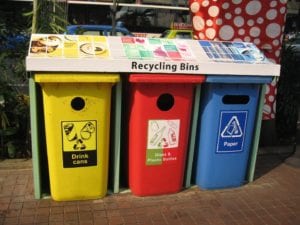By Rick Fedrizzi, CEO and Founding Chair, U.S. Green Building Council
We split the atom. We invented the light bulb. Heck, we not only sent a man to the moon, we brought him back again. Why, then, can we not get recycling right? As the New York Times columnist and author John Tierney recently wrote, recycling is costly, complicated and inefficient, which prompts him to ask the sticky question: so why do we still do it? The last part is easy. We continue to recycle, and do so the world over, because the alternative would be too frightening to consider, not to mention self-destructive. Cost constraints But it’s the first part I’m having trouble wrapping my brain around. Why, decades after its broad acceptance, does recycling still cost as much as it does? Why does it remain so ridiculously inefficient? And why does it rely so utterly on human behavior and a society’s collective sense of social responsibility to actually work? So as of today, and as the head of an organisation dedicated to the very notion of sustainability, I am hereby laying down the gauntlet to researchers, scientists, urban planners, environmentalists and concerned citizens everywhere. Let’s fix recycling – and I mean truly fix it. I don’t mean fix it in a behavioral way or in a reactive way. Because, let’s face it, certain people in this world, if not certain governments, are simply never going to embrace high levels of environmental responsibility.What we need to do is fix recycling by re-inventing it from A to Z. We need to deconstruct and re-imagine the entire process with a fresh mind and an entirely new set of eyes. We need to blow up every last one of our preconceived notions. We need to take nothing, and I mean nothing, as a given. And we need to stop focusing so much of our attention at the tail end of the consumer process and start looking hard at the front end.
We need to reconsider how me make and package every last one of the millions of consumer products we buy, sell and use every day. And I mean reconsider them down to their DNA – down to their molecular level. Because my sense is that’s where we’re going to stumble upon an “aha” moment in our understanding. Starting at the beginning So let’s make today Day One. From this point forward, let’s urge our scientific and environmental communities to rise to this challenge. Let’s demand they start re-imagining the very makeup and nature of the products we consume. We know we can do it. Over 20 years ago, the US Green Building Council did this very same thing with American buildings, deconstructing and re-imagining the essence of the physical structures US builders are paid to erect and that we continue to inhabit. While that has been a major step toward a fully sustainable future, we still have a long way to go, and reimagining recycling can get us even closer. It may take years, if not decades. And the clock is ticking. And it will continue to tick as populations around the world explode and as the earth’s resources remain threatened and/or devastated by one non-sustainable method of harvesting after another. So the choice is ours. We can continue to hit ourselves over the head, and we can continue to try one new helmet after another to try to absorb the blows. Or we could, just maybe, decide to stop hitting ourselves over the head altogether. Source: www.huffingtonpost.com







